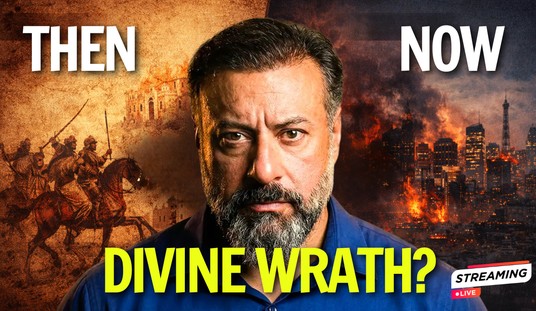When my son was small, he was kicked out of more daycares and classrooms than I can count. He could speak, but not communicate. His meltdowns were volcanic — violent enough that the call would always come: “You need to come get him. Now.” I began to dread the phone ringing. He simply didn’t fit in the slots the world offered.
I knew what that felt like. As an autistic child myself, I experienced the world as fragments: scattered sensations, contradictory rules, people who seemed to operate on a script no one had given me. I learned to survive by building my own scaffolding of meaning — a personal structure of story and symbols that held me together when life itself didn’t. Without it, I don’t think I would have made it intact.
My son didn’t yet have that scaffolding. He had chaos. And chaos was swallowing him whole.
So I did the only thing I could think of: I gave him a story to live inside.
It happened, of all places, at a Renaissance fair. He was seven years old, wide-eyed, when he was called forward for a little public ceremony. The knight drew his sword, tapped him on the shoulder, and declared him a knight. For most families, that would have been a fun photo-op. For us, it was a turning point.
Because when we got home, his father and I decided we weren’t going to let that moment fade into a souvenir. We were going to treat it as real.
We bought him a wooden sword and shield — not the flimsy kind, but something that felt solid in his hand. On the shield, he drew a coat-of-arms of his own invention, and I dug into heraldry to make sure it followed the real rules. We painted it together, stroke by stroke, until it wasn’t just decoration but his banner.
We framed the knighthood certificate from the fair and hung it on the wall. Not as a keepsake, but as a charter—a reminder that he had a role and a code to live by.
When Halloween rolled around, I hand-stitched him a knight’s costume. He wore it with the gravity of someone who knew he wasn’t “pretending.” He was putting on his identity.
And on his birthday, a few days before Halloween, I made him a castle cake: chocolate frosting covered with Hershey bar rectangles as bricks, cupcake towers anchoring the corners, even a Twizzler drawbridge stretching out to meet the world. He saw it and grinned like a boy who had been given a kingdom.
We treated the whole thing not as a passing childhood fancy, but as a serious initiation. We told him: You are a knight now. That means something. Knights protect. Knights are noble. Knights do not give in to rage. Knights fight for the good.
And something remarkable began to happen. The boy who couldn’t control his meltdowns now had a story big enough to contain his anger. The child who had been expelled from classrooms now had a code of honor to live by. He had scaffolding. He had myth.
The Mythic Function
What happened with my son wasn’t just a clever parenting hack. It was something older, something deeper. Cultures have always given their children myths to live inside — and then marked those myths with rituals, symbols, and celebrations. That’s how stories sink into the bones.
The knight became my son’s myth because knights embody exactly what he needed: honor, loyalty, courage, and self-control. They carry swords, but they’re sworn to use them in the service of good. That story gave him a framework for emotions too big to handle on their own.
And we didn’t just tell him the story — we enacted it. The sword, the shield, the costume, the framed certificate, the castle cake — all of these were sacraments of the myth, physical reminders that it was real and binding.
It worked because myth always works this way. Story by itself is powerful, but when you ground it in ritual, it becomes identity. It stops being “pretend” and becomes “who I am.” For my son, the knight wasn’t just a Halloween costume. It was the scaffolding he needed to grow strong, steady, and noble.
The Paladin Years
As he grew older, the myth grew with him. Story didn’t stop at the Renaissance fair; it expanded into the worlds we built together at the D&D gaming table. Role-playing gave him a safe space to practice the very skills he struggled with in daily life: listening, taking turns, weighing choices, and imagining how other people might feel.
And almost without exception, he chose to play a paladin. It was the knight’s story, but with the volume turned up. Paladins don’t just swing swords — they swear oaths. They live by codes. They serve something higher than themselves.
Game after game, he stepped into that role. He learned how to negotiate, how to lead, how to restrain anger, how to protect others. Each dice roll became another rehearsal in what it meant to be noble. And because he was practicing under the cover of “pretend,” he could try, fail, and try again without shame.
Over time, the scaffolding held. He wasn’t locked into paladin forever — eventually, he experimented with other characters — but the core remained. The noble knight had become part of him.
Today he is functional, flexible, and independent. But beneath all that, he still carries the same code we gave him when he was seven: a knight’s heart, a paladin’s oath.
Why It Worked
What changed my son’s life wasn’t stricter discipline or better behavior charts. We had tried those, and they never touched the root of the problem. What he needed wasn’t punishment; what he needed was coherence.
Autism makes the world feel fragmented: sounds, rules, emotions, expectations — all coming in sharp and jagged, with no frame to hold them together. But children in general, autistic or not, share that same craving. They need to know: Who am I? What is my role? Where do I belong?
Story answers those questions. Story doesn’t just entertain — it organizes. It gives shape to chaos. And when parents treat story seriously, it becomes a structure strong enough for a child to stand on.
That’s what the knighthood gave him. It wasn’t escapism. It wasn’t pretending. It was scaffolding. The knight’s story handed him a moral compass when raw emotion would have swallowed him. It gave him an identity larger than his anger, a framework for how to act when he didn’t know what else to do.
And the best part? It didn’t just work for my autistic son. This is how human beings have always been raised. Every culture has its myths, its rites, its heroes for children to imitate. We’ve just forgotten to take them seriously.
Mythic Parenting for Every Child
The truth is, my son’s knighthood wasn’t just a solution for autism. It was a rediscovery of something every child needs: a myth to live inside.
All children crave identity. They want to know who they are, what they stand for, and what role they play in the world. If parents don’t provide that scaffolding, something else will — peers, celebrities, online subcultures, ideologies. And those stories are rarely kind.
Knighthood worked for us, but it isn’t the only framework parents can draw on. You can build almost any mythic structure, so long as you treat it seriously and back it with ritual, symbol, and story. A few examples:
- The Knight: Honor, service, protection of the weak. Think King Arthur, Sir Galahad, or the old TV Western hero Paladin. For modern kids, it might be the paladin class from Dungeons & Dragons — sworn to justice and truth.
- The Adventurer: Curiosity, courage, resilience. Indiana Jones, Marco Polo, or even a race car driver circling the track at impossible speed. The archetype is about bold exploration, wherever it leads.
- The Steward: Responsibility, care for what is entrusted. Tolkien’s Sam Gamgee tending his garden, Saint Francis with his animals, or a modern child entrusted with the family dog.
- The Healer: Empathy, compassion, sacrifice. Florence Nightingale with her lamp, a village midwife, or the fantasy cleric who restores the wounded. The archetype tells a child their calling is to mend what is broken.
- The Builder: Patience, endurance, creativity. Noah building his ark plank by plank, a medieval cathedral mason, or today’s young Lego or Minecraft enthusiast stacking worlds into being.
What matters most is not the specific archetype but the seriousness with which it’s given. A framed certificate, a family ritual, a costume, a symbol — these are the sacraments of myth. They tell a child: This is who you are. This is what you stand for. This is the story you belong to.
And once a child believes they are living in a story, they rise to it.
Recommended: Our Summer of Omelas
In Closing: Give Them a Story
My son began as the boy who couldn’t stay in daycare, who melted down until the phone rang with yet another urgent call to pick him up. Today, he is a functional, flexible adult who still carries a noble heart at his core. What made the difference wasn’t a medication or a better behavior chart. It was a story — a story big enough to hold him, to give him scaffolding, to make sense of his chaos.
Every child needs that. Autistic or not, troubled or not, every child is searching for a myth to live inside. If parents don’t give them one, something else will: TikTok trends, peer cliques, ideologies that prey on confusion.
But when parents do take story seriously — when they offer not just words but symbols, rituals, and identity — it changes everything. The boy becomes a knight. The curious girl becomes an adventurer. The quiet child becomes a healer. The restless one becomes a builder. And each of them finds coherence where there was only chaos.
So don’t dismiss the myths your children long for. Knight them. Crown them. Entrust them with a banner, a lamp, a compass, a trowel. Let them know their story matters — and treat it with the weight it deserves.
Give them a story worth living in, and you just might change their world.
Editor’s Note: Do you enjoy PJ Media’s conservative reporting that takes on the radical left and woke media? Support our work so that we can continue to bring you the truth. Join PJ Media VIP and use the promo code FIGHT to get 60% off your VIP membership!









Join the conversation as a VIP Member